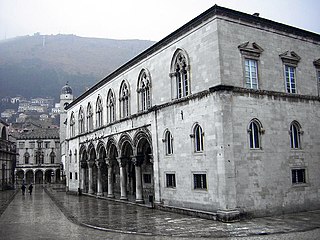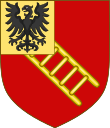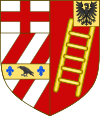
Dalmatian or Dalmatic was a Romance language that was spoken in the Dalmatia region of present-day Croatia, and as far south as Kotor in Montenegro. The name refers to a tribe of the Illyrian linguistic group, Dalmatae. The Ragusan dialect of Dalmatian, the most studied prestige dialect, was the official language of the Republic of Ragusa for much of its medieval history until it was gradually supplanted by other local languages.
Francesco Maria Appendini was an Italian Latin and Italian scholar who studied Slavic languages in the Republic of Ragusa. The French invasion prevented him from returning to Italy, and he adopted Republic of Ragusa as his own country. He took it upon himself to investigate its history and antiquities.

The Republic of Ragusa was an aristocratic maritime republic centered on the city of Dubrovnik in South Dalmatia that carried that name from 1358 until 1808. It reached its commercial peak in the 15th and the 16th centuries, before being conquered by Napoleon's French Empire and formally annexed by the Napoleonic Kingdom of Italy in 1808. It had a population of about 30,000 people, of whom 5,000 lived within the city walls. Its motto was "Non bene pro toto libertas venditur auro", a Latin phrase which can be translated "Liberty is not well sold for all the gold".

Cavtat is a village in the Dubrovnik-Neretva County of Croatia. It is on the Adriatic Sea coast 15 kilometres south of Dubrovnik and is the centre and the main settlement of Konavle municipality.

The House of Gundulić was a noble family of the Republic of Ragusa, considered one of the most prestigious families of the republic. It had origins in southern Dalmatia and Tyrol. The family´s motto is Tout ou rien.

Junije (Džono) Palmotić, was a Croatian baroque writer, poet and dramatist from the Republic of Ragusa. He was a member of the Palmotić noble family.

The House of Sorgo or Sorkočević was the name of a noble family of the Republic of Ragusa.

The House of Pucić, known also as Pozza in Italian, is a noble family from the Republic of Ragusa.

The House of Božidarević or House de Bosdari is a noble family (patrician) of the city of Dubrovnik, dating from the Republic of Ragusa and Ancona, Italy.

Orsat "Medo" Pucić, was a Ragusan writer and an important member of the Catholic Serb movement.

Benedetto Stay (1714–1801) was a Ragusan Roman Catholic clergyman, educated by Jesuits, he attended the academic assemblies of Marin Sorgo, beginning the composition of a poem on Alexander Farnese. Later on, he published "Saggio sull'uomo", based on the system of Descartes.

The House of Gradi or Gradić was one of the oldest and one of the most recognized among the patrician families in the Republic of Ragusa. Many of its members were Rectors (Knez) of the Republic. The Austrian Empire recognized its long-standing nobility on 1 December 1817 after the fall of the Republic.
Epidaurus or Epidauros was an ancient Greek colony founded sometime in the 6th century BC and renamed to Epidaurum during Roman rule in 228 BC, when it was part of the province of Illyricum and later of Dalmatia. It is located at present-day Cavtat in Croatia, 15 km (9 mi) south of Dubrovnik.

The House of Cerva or Crijević was a Ragusan noble family from Ragusa, which held noble titles in the Republic of Ragusa, and in the Austrian and Austro-Hungarian empires. Descendants of the family live in Austria and Italy.

The Giorgi or Zorzi were a noble family of the Republic of Venice and the Republic of Ragusa.

The House of Bobali or Babalio was a noble family of the Republic of Ragusa.

The House of Buća was a noble Serbian family that served the Republic of Ragusa, and one of the most important families to come out of Kotor. A cadet branch was admitted to the nobility of the Republic of Ragusa, another branch moved instead to Šibenik.

Giorgio Raguseo (1580–1622) was an Italian philosopher, theologist, and orator from the Republic of Venice.

The rector was an official in the government of the Republic of Ragusa. The holder was the head of the executive powers of Ragusa, part of the Small Council. The rector was seated at the Rector's Palace.




















